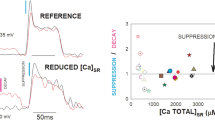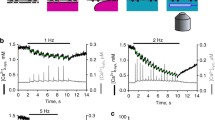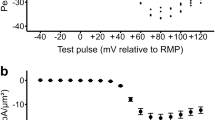Abstract
It is widely believed that Ca release from the sarcoplasmic reticulum (SR) in heart muscle is due to ”Ca-induced Ca-release” (CICR), triggered by transmembrane Ca entry. However, in intact guinea-pig cells or cells dialysed with cAMP there may be an additional mechanism – SR release may be activated directly by membrane depolarisation without Ca entry. The first objective of the present study was to investigate whether this ”voltage-activated Ca release” (VACR) mechanism is present across species such as rabbit, rat and guinea-pig. The second objective was to characterise the dependence of a VACR mechanism on internal [cAMP]. Membrane current was measured with the whole-cell patch-clamp technique, intracellular [Ca] was monitored with Fura-2 (or a combination of Fluo-3/SNARF-1). Rapid changes of superfusate (within 100 ms) were made using a system which maintained cell temperature at 37°C. We used a train of conditioning pulses to ensure a standard SR load before each test pulse. In rabbit myocytes dialysed with 100 μM cAMP, 89.6 ± 7.0% of the control intracellular Ca (Cai) transient was still elicited by depolarisation during a switch to 5 mM Ni, which blocked pathways for Ca entry. This suggested that rabbit myocytes possess a VACR mechanism. The percentage of control Cai transient elicited by depolarisation in the presence of 5 mM Ni (i.e. magnitude of VACR) increased in a graded fashion with the pipette [cAMP] between zero and 100 μM. In rat myocytes dialysed with 50 μM cAMP, 64.4 ± 6.2% of SR release was activated by depolarisation in the presence of 5 mM Ni, suggesting the presence of a VACR mechanism. The extent to which VACR triggered SR release increased with the pipette [cAMP] between zero and 50 μM. In guinea-pig myocytes dialysed with 100 μM cAMP, 74.6 ± 3.6% of the control Cai transient was elicited by depolarisation in the presence of 5 mM Ni. The degree to which VACR triggered SR release was also graded with the pipette [cAMP] between zero and 100 μM. It therefore appears that each of the three species might possess a VACR mechanism which can be modulated by the internal [cAMP]. This may reflect an effect of cAMP to phosphorylate key proteins involved in excitation–contraction coupling. Under normal physiological conditions with a basal [cAMP] between 2 and 20 μM, VACR may play a role in triggering SR release. The role of VACR may increase under conditions which increase internal [cAMP].
Similar content being viewed by others
Author information
Authors and Affiliations
Additional information
Received: 4 April 1997 / Received after revision: 2 July 1997 / Accepted: 7 July 1997
Rights and permissions
About this article
Cite this article
Hobai, I., Howarth, F., Pabbathi, V. et al. ”Voltage-activated Ca release” in rabbit, rat and guinea-pig cardiac myocytes, and modulation by internal cAMP. Pflügers Arch 435, 164–173 (1997). https://doi.org/10.1007/s004240050496
Issue Date:
DOI: https://doi.org/10.1007/s004240050496




